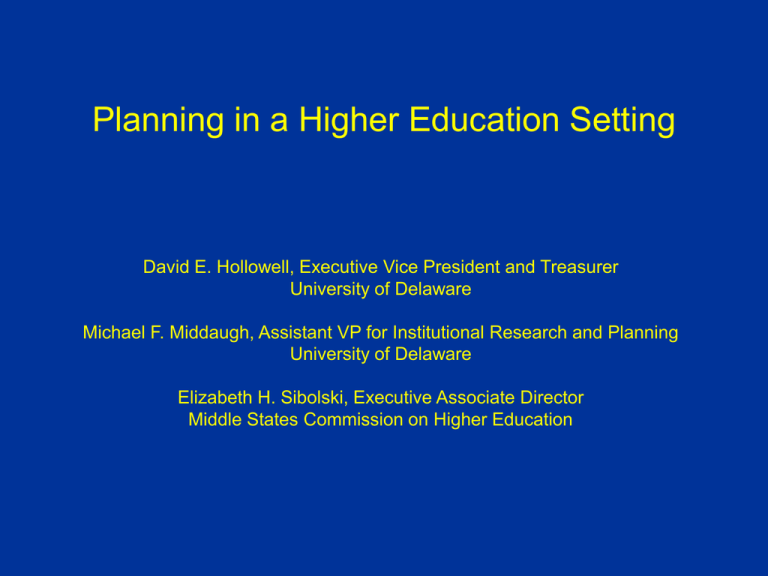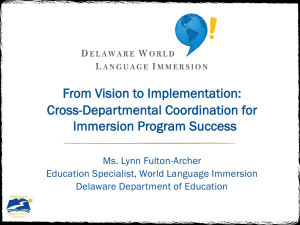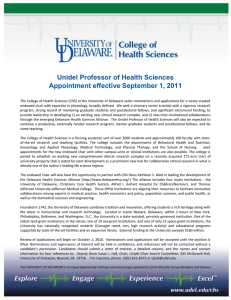Planning and Analysis as Essential Components of Institutional and
advertisement

Planning in a Higher Education Setting David E. Hollowell, Executive Vice President and Treasurer University of Delaware Michael F. Middaugh, Assistant VP for Institutional Research and Planning University of Delaware Elizabeth H. Sibolski, Executive Associate Director Middle States Commission on Higher Education Elizabeth Sibolski Associate Executive Director Middle States Commission on Higher Education “The nicest thing about not planning is that failure comes as a complete surprise and is not preceded by a period of worry and depression.” John Preston, Boston College “Whatever failures I have known, whatever errors I have committed, whatever follies I have witnessed in private and public life have been the consequence of action without thought.” Bernard M. Baruch Regional and professional accreditation agencies across the United States are explicitly requiring demonstrable evidence of planning processes that are systematic, and that are rooted in quantitative and qualitative information. Central Threads Running Through Regional and Specialized Accreditation Requirements: • Planning must be systematic • Planning must be rooted in an institution’s mission • Planning must be predicated on analytical and evaluative information • Planning must be used for institutional decisions, especially resource allocation Middle States Accreditation Standards Standard 2: An institution conducts ongoing planning and resource allocation based on its mission, and utilizes the results of its assessment activities for institutional renewal. Implementation and subsequent evaluation of the success of the strategic plan and resource allocation support the development and change necessary to improve and to maintain institutional quality. Middle States Accreditation Standards Standard 7: The institution has developed and implemented an assessment plan and process that evaluates its overall effectiveness in: achieving its mission and goals; implementing planning, resource allocation, and institutional renewal processes; using institutional resources efficiently; providing leadership and governance; providing administrative structures and services; demonstrating institutional integrity; and assuring that institutional processes and resources support appropriate learning and other outcomes for its students and graduates. What Plans Are Required? • Under Standard 2, one or more planning documents are needed to demonstrate required “planning and improvement processes.” • Planning processes and related documents may be comprehensive and institution-wide or may be decentralized or individually focused. • Budgets, facilities or infrastructure master plans, and technology plans are mentioned under Standard 3. What Plans Are Required? Continued • The final fundamental element under Standard 7 requires a written institutional (strategic) plan. • Fundamental elements under Standard 7 also require a written assessment plan and process for the assessment of overall institutional effectiveness. Conceptually, this assessment umbrella includes the assessment of student learning as addressed under Standard 14. End Result • Institutions must plan in order to be effective. • Where that is the case, the accreditation process is nothing more than a simple affirmation of the evidence of that effectiveness. Michael Middaugh Asst. Vice President – Inst. Research & Planning University of Delaware Commissioner, MSA Commission on Higher Education A Typology of Planning Processes • Long Range Planning • Strategic Planning • Tactical Planning Long Range Planning • Typically looks at all facets of the organization – academics, student life, administration, facilities, etc. Examination occurs within context of institutional mission, and total institutional direction is charted through a series of planning goals and objectives that are clearly tied to the institution’s mission. • Broadly participatory in nature. • Long range planning time frame for implementation is several years. Strategic Planning • Typically focuses on those planning goals and objectives that are of the highest priority to the institution. Planning is highly opportunistic. Ongoing environmental scanning identifies circumstances and resources that allow goals and objectives to be rapidly achieved in a short time frame. • While participatory in nature, the participation is frequently targeted to constituencies that can facilitate implementation. • Strategic planning time frame for implementation is usually months to a few years. Tactical Planning • Typically directed at implementation of long range and strategic planning goals and objectives. Identifies resources required – both human and fiscal – and provides a clear direction for deployment of those resources. • Tactical planning is less participatory, more managementoriented. • Timeframe for tactical planning implementation is “now.” Essential Components of Long Range Planning INSTITUTION MISSION ACTIONORIENTED GOALS ACTIONORIENTED GOALS ACTIONORIENTED GOALS Measurable Objectives Measurable Objectives Measurable Objectives Mission Statement • A good mission statement is a carefully reasoned analysis of what an institution aspires to be, and the core values that it embraces. • It avoids cliché language, e.g., “Students and faculty will interact in a rich intellectual environment in which each individual has the opportunity to achieve their full potential.” Noble sentiment, but says nothing about the institution’s purposes and priorities. • Mission must speak to central institutional issues, e.g., desired balance between undergraduate and graduate education; relative emphasis on teaching, research, and service, respectively; and so on. Mission Statement • Mission statements are characterized by a sense of vision that, while not immutable, nonetheless represents a long-term statement of institutional values and direction around which human and fiscal resource allocation decisions can be made. • While cognizant of the institution’s ever changing external environment, mission statements are not whimsical, morphing with each new market trend that emerges. • The mission statement provides a clear sense of direction around which action-oriented goal statements and measurable planning objectives can be developed. Planning Goals • Goal statements are derived from the institutional mission, and help to define policy. • For example, the mission statement might say that “The University affirms its historic mission of providing the highest quality education for its undergraduate students, while maintaining excellence in selected graduate programs.” • The mission statement is underscoring the primacy of undergraduate instruction in the curriculum. The question for planners is how to provide that high quality undergraduate instruction. Planning Goals • The “how” translates into specific, action-oriented planning goals aimed at moving the institution toward a fuller realization of its mission. • Possible goal related to the undergraduate education mission statement: “The University will continue to attract and retain the most academically talented and diverse undergraduate students, and support their intellectual, cultural, and ethical development as citizens, scholars, and citizens.” • Action verbs such as “attract,” “retain,” and “support” elevate the goal statement to policy level. How do we know that policy is being carried out? Measurable planning objectives. Planning Objectives Planning objectives provide empirical evidence of the extent to which planning goals are being achieved. Consider the following planning objectives as they relate to our goal to attract, retain, and support academically talented and diverse students. • Retain a freshman admissions target of 3200 to 3400 students annually, with an admissions profile for academic year 2007 of 23,000 applications, a 40 percent admit rate, and a yield rate ion excess of 35 percent. • Improve the alignment of undergraduate enrollment distribution and instructional resource distribution across the disciplines, especially with respect to faculty. Planning Objectives • Maintain a freshman-to-sophomore retention rate above the national average for highly selective institutions, and seek to achieve a consistent rate of 90 percent or higher. • Maintain a graduation rate above the national average for highly selective institutions, and seek to achieve a consistent six-year rate of 75 percent or higher. • Increase minority and international enrollment, with retention and graduation rates for those populations consistent with the university-wide averages for all students. Planning Objectives • The defining characteristic for any good planning objective is that it must be measurable. • Colleges or universities embarking on any planning process – long range, strategic, tactical – require a systematic institutional research capability. • While smaller institutions may not have an office of institutional research, per se, they must nonetheless have the capability of quantitatively and qualitatively assessing the extent to which planning objectives are being implemented, planning goals are being achieved, and the institutions mission is being realized. David Hollowell Executive Vice President and Treasurer University of Delaware Member, Board of Directors Middle States Association of Colleges and Schools Long Range Planning is comprehensive, integrating and synthesizing a broad range of planning goals and objectives that are derived from the overarching umbrella of the institution’s mission. It is not unusual for a long range plan to be an extensive document, with goals and objectives grouped under headings such as: • Program and Curriculum • Student Services • Faculty • Administration • Admissions • Governance • Academic Support Services • Physical Plant & Equipment • Research and Public Service • Finances Strategic Planning • As important as long-range planning is in setting a comprehensive direction for institutional decisions and resource allocations, the very magnitude of a long range plan is limiting. • Simply put, there are insufficient resources at any one point in time to fund all of the goals and objectives typically articulated in a long range plan. • Institutions are forced to prioritize those goals and objectives that are of immediate importance, and to allocate resources accordingly. In other words, they must think and behave strategically. Case Study – University of Delaware • In 1987, the University embarked on a comprehensive, longrange planning process, termed Project Vision. Over a period of 18 months, the campus developed a planning document with a broad spectrum of planning goals and measurable objectives embracing all aspects of University operations. • In Fall of 1988, the President who initiated Project Vision suddenly resigned. At the same time, the Delaware economy along with that of the entire mid-Atlantic region was plunging into deep recession Case Study – University of Delaware • Rather than let 18 months of planning activity go for naught – even though resources would be scarce for the foreseeable future – a panel of distinguished senior faculty was assembled to review the Project Vision planning document and to cull out those goals and objectives that were clearly consistent with, and essential to furthering the University mission. • The resulting document, Focused Vision, was economical when compared with its progenitor, both in terms of words and resource requirements. However, the economy would still clearly preclude anything even remotely approaching implementation. • In 1990, the University hired its 25th President, David P. Roselle. Case Study – University of Delaware • In order to maintain planning momentum, the President consulted with his senior staff, the faculty, and appropriate constituencies across campus to determine those areas that required immediate attention. • From these consultations, the President articulated four strategic initiatives that would constitute the focus of decision-making and resource allocation activity in the immediate future. Those initiatives were competitive compensation for faculty and staff; enhanced access to the University for undergraduates through expanded availability of financial aid; a more student-centered campus environment; and renovation and rehabilitation of campus facilities. Case Study – University of Delaware These priorities were not a “wish list.” They grew out of a careful examination of empirical data provided by the University’s Office of Institutional Research and Planning and other data sources. Consider the following: • When compared with the 24 Category Doctoral I universities in the states contiguous to Delaware, and the District of Columbia, in 1991 the average salary for all three major faculty ranks at the University of Delaware ranked near the bottom of the list. • The Student College Selection Survey indicated that students were receiving offers of more aid from admissions competitors, and that the aid packages had more grants and fewer loans than University aid packages. Not surprising, the University was at a competitive disadvantage for academically talented students. Case Study – University of Delaware • University scores on the ACT Student Opinion Survey suggested that the institution had considerable room for improvement with respect to student satisfaction with programs and services, and with a number of areas in student life. • The University was looking at in excess of $200 million in deferred maintenance to its buildings and grounds. • Note: The ability to use an institutional research capability to quantitatively and qualitatively assess where a college or university is with respect to all aspects of its operations is the only way to chart where the institution needs to go, and how to get there. Case Study – University of Delaware • A critical factor in moving forward with these initiatives was getting the campus to understand that the economy was in recession and that there would be no immediate or massive infusions of new resources. • Colleges and universities have multiple revenue streams – tuition, state appropriation in the case of public institutions, contracts and grants, gifts, etc. While growing revenue streams is an important strategic initiative, so too is the commitment to not balance budgets on the backs of students through inordinately large tuition increases. • Resource reallocation would be the primary source of funding the four strategic initiatives, and it was critical that the campus understand from where funds were reallocated, and why. The University went on public record in 1991: • Average total compensation for faculty at each academic rank would be at or above the median within five years for the 24 Category I Doctoral Universities identified as salary peers. • Total undergraduate financial aid from all sources would increase by 100 percent within five years. • Student satisfaction with programs and services at the University, as measured through the ACT Student Opinion Survey would demonstrate significant gains within five years. • The University would commit itself to a policy of annually setting aside at least 2 percent of the replacement value of the physical plant, to be used for facilities renovation and rehabilitation. Results - Salaries Total Compensation, 1989-90 Compared with 1999-2000 FULL PROFESSOR Institution 1989-90 1999-2000 Princeton University 91,800 University of Pennsylvania 151,900 University of Pennsylvania 91,500 Princeton University 134,100 Georgetown University 88,700 Georgetown University 126,100 Carnegie-Mellon University 85,800 Carnegie-Mellon University 123,200 University of Virginia 85,100 University of Virginia 122,900 George Mason University 84,400 UNIVERSITY OF DELAWARE 116,200 Johns Hopkins University 83,800 Temple University 114,300 New Jersey Institute of Technology 83,100 George Mason University 113,900 Rutgers University - New Brunswick 82,000 College of William and Mary 113,400 Lehigh University 80,800 Lehigh University 111,300 University of Maryland - College Park 80,500 American University 111,100 Virginia Polytechnic Inst. & State University 76,700 Johns Hopkins University 110,800 ------------------------------------------------------------------------------------------------------------------------------------------------------University of Maryland - Baltimore County 76,700 George Washington University 110,800 ------------------------------------------------------------------------------------------------------------------------------------------------------University of Pittsburgh - Main Campus 76,500 New Jersey Institute of Technology 109,200 George Washington University 76,500 Rutgers State University-N.Brswck 109,000 American University 76,300 Pennsylvania State University 108,600 Pennsylvania State University 75,300 University of Maryland - College Park 106,800 UNIVERSITY OF DELAWARE 74,700 University of Pittsburgh - Main Campus 105,600 College of William and Mary 74,400 Virginia Polytechnic Inst. & State University 103,800 Virginia Commonwealth University 72,600 Drexel University 103,700 Drexel University 71,000 Virginia Commonwealth University 103,300 Old Dominion University 70,400 University of Maryland - Baltimore County 96,200 Temple University 68,400 Howard University 93,300 Catholic University of America 64,800 Catholic University of America Howard University 64,000 Old Dominion University 86,800 No Report Results – Financial Aid Growth In Undergraduate Financial Aid at the University of Delaware, FY 1990 Compared with FY 2000 FY 1990 FY 2000 % Increase University Administered Funds $4,458,640 $28,036,660 528.8 State Grant Funds $3,869,000 $6,643,500 71.7 Other Fund Sources $2,169,602 $4,394,180 102.5 $10,497,242 $39,074,340 272.2 TOTAL Results – Student Satisfaction Comparison of 1995 University of Delaware Scores on ACT Student Opinion Survey with 1990 Scores and with National Norms 1990 Scores Compared with National Norms 1995 Scores Compared With 1990 Scores 1995 Scores Compared with National Norms University is Ahead 21 44 39 University is Tied 14 11 15 University is Behind 27 7 8 Results - Facilities • By 2000, the University had renovated every classroom in its entire building inventory, retrofitting most with state-of-the-art teaching technology. • An aggressive program of fundraising enabled not only the aforementioned renovation and rehabilitation, but also the construction of several new classroom and student services buildings. • The University is now on a cycle of planned maintenance, as opposed to deferred maintenance. Results – From an Accreditation Perspective “ The University of Delaware has every reason to take enormous pride in what it has accomplished over the past 10 years. A decade ago, it was coming out of a period of considerable turmoil. Today, the University is seen as a national model for the integration of information technology in every aspect of university life: teaching and learning, research and service, academic support, and campus administration. It has created a physical plant that has few, if any, peers among public universities and would be the envy of most private colleges. These substantial achievements could not have happened without extraordinary leadership from the senior administration.” “ Better than almost any university we are familiar with, Delaware has a clear sense of what it wants to be, namely, a university that offers high quality undergraduate education with targeted areas of excellence in graduate education and research.” " The review team was enormously impressed by the high level of morale that pervades the faculty, staff, and students. Almost without exception, the people we spoke to take great pride in being part of the University.” 2001 Middle States Evaluation Team Report Questions??? esibolski@msache.org middaugh@udel.edu execvp@udel.edu Thank You!



